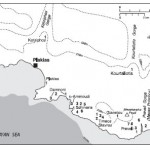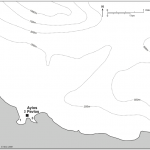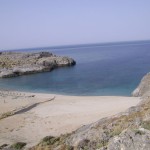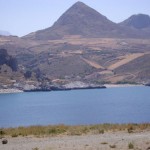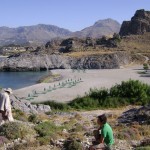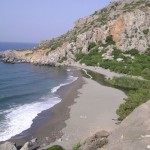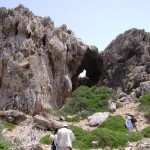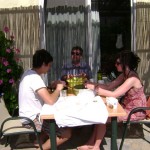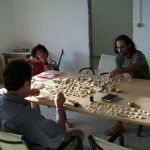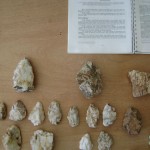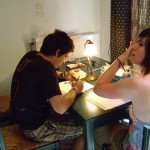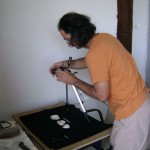The summer of 2008 was focused on discovering Mesolithic artifacts by conducting surface reconnaissance in areas that hunter-gatherers were likely to favor; such as places that are well-watered and have south-facing caves to take advantage of the sun’s warmth. We chose the southwestern coast of Crete near the towns of Plakias and Ayios Pavlos, which face the Libya Sea. This method and research area proved successful and nineteen Mesolithic sites were found.
To the team’s surprise Palaeolithic artifacts were also found on the flanks of the Preveli Gorge, where fossilized beach terraces preserve the tools and the specialists agree that these tools, such as hand-axes and cleavers, date to an early phase of the Palaeolithic. Consequently, the survey was continued in 2009, when several more Palaeolithic archaeological sites were found, and now nine are known.
- Map of Plakias and Preveli Gorge area showing location of Mesolithic and Palaeolithic sites.
- Map of Ayios Pavlos area showing location of Mesolithic and Palaeolithic sites.
- Schinaria beach. Such a cove, with fresh water streaming into it, was desirable to the Mesolithic people because at times of lower sea levels, it was a brackish haven for wildlife. Sites were found nearby.
- The Amoudi beaches, now popular with tourists, were also brackish coves in the early Holocene. The survey found sites on the flanks of these beaches.
- Another view of an Amoudi beach, with a straw-lined stream in the foreground.
- Preveli Gorge from the east, where the first Palaeolithic tools were found.
- A partially collapsed limestone cave near the village of Ayios Pavlos. The survey targeted such south facing caves because they took advantage of the sun’s warmth and were therefore desirable to Stone Age hunter-gatherers.
- Once a collection was made, the artifacts were washed.
- The collections were then analyzed, and non-artifactual stones were removed.
- The artifacts are classified.
- Chad DiGregorio and Natalie Cooper pencil draw the important artifacts. Later these drawings are inked for publication.
- Nicholas Thompson photographs the artifacts.


